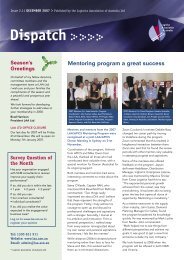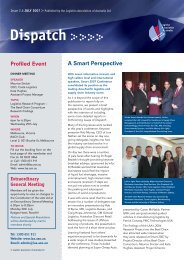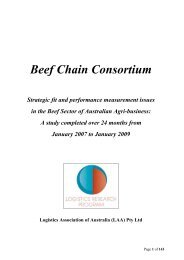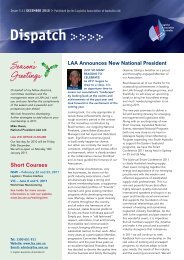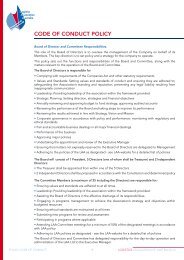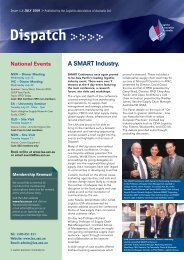Supply Chain Report - Logistics Association of Australia
Supply Chain Report - Logistics Association of Australia
Supply Chain Report - Logistics Association of Australia
You also want an ePaper? Increase the reach of your titles
YUMPU automatically turns print PDFs into web optimized ePapers that Google loves.
S u p p l y C h a i n R e p o r t 2 0 1 0<br />
Employment in Transport and Storage Industry by Gender<br />
• The industry’s workforce remains dominated by<br />
males. The proportion <strong>of</strong> male-to-female<br />
employment has remained virtually unchanged<br />
during the past decade.<br />
• In the August 2010 quarter, male employment<br />
represented approximately 78% <strong>of</strong> the total<br />
workforce.<br />
100%<br />
90%<br />
80%<br />
70%<br />
60%<br />
50%<br />
40%<br />
30%<br />
20%<br />
10%<br />
Workforce by Gender (Quarterly)<br />
August 2000 to August 2010<br />
Transport and Warehouse Workforce by Gender<br />
Percent Female<br />
Percent Male<br />
0%<br />
Aug<br />
00<br />
Aug<br />
01<br />
Aug<br />
02<br />
Aug<br />
03<br />
Aug<br />
04<br />
Aug<br />
05<br />
Aug<br />
06<br />
Aug<br />
07<br />
Aug<br />
08<br />
Aug<br />
09<br />
Aug<br />
10<br />
Source: ABS [28]<br />
Employment in Transport and Storage Industry by Age<br />
• There is growing concern over the high proportion<br />
<strong>of</strong> themature workforce in the industry.<br />
• It is suggested that the proportion <strong>of</strong> the mature<br />
workforce is amongst the highest <strong>of</strong> all industries,<br />
second only to Agriculture, Education and Health<br />
Care. [5]<br />
• The figure illustrates the movement <strong>of</strong> workforce<br />
proportion by age group over the past decade.<br />
• The percentage <strong>of</strong> workforce aged over 45 years<br />
grew from 36% in 2000 to 44% in 2010.<br />
• The <strong>Australia</strong>n Transport Council (ATC) has included<br />
the fact as a key issue when developing a strategic<br />
action plan for National Workforce Planning and Skills. [20]<br />
• The ALC seeks industry collaboration and coordination<br />
to support and act in the identified areas for action.<br />
30%<br />
25%<br />
20%<br />
15%<br />
10%<br />
5%<br />
0%<br />
Source: ABS [37]<br />
Workforce by Age Group<br />
Transport and Warehouse Workforce by Age Group<br />
2000<br />
2005<br />
2010<br />
15-19 20-24 25-34 35-44 45-54 55-59 60-64 65 and<br />
over<br />
Education and Training in <strong>Logistics</strong><br />
• Major channels which provide education and training in <strong>Logistics</strong> remain the same being:<br />
- Universities and Colleges providing qualifications from Bachelor degree to Doctorate. Degrees in the area <strong>of</strong> Operations<br />
Management, <strong>Supply</strong> <strong>Chain</strong> Management and Engineering are being <strong>of</strong>fered at most <strong>of</strong> the universities/colleges.<br />
- In terms <strong>of</strong> vocational studies, TAFE Institutions and Colleges provide short courses, Certificates I-IV and Diplomas in different<br />
areas ranging from purchasing, transport, warehousing, maritime and aviation.<br />
- Training Institutions <strong>of</strong>fer courses (some <strong>of</strong> which are government funded) similar to the certificates and short courses <strong>of</strong>fered by TAFE.<br />
- Several companies in the industry also provide internal development programs, such as the graduate Program or Traineeship -<br />
Program <strong>of</strong>fered by Linfox and DHL.<br />
- Other training channels include: LAA/apics which coordinates a mentoring program and short courses, TLISC which provides<br />
training packages in Transport, <strong>Logistics</strong>, Maritime and Aviation, TDT Victoria which <strong>of</strong>fers cadetship programs related to<br />
Transport, Distribution and <strong>Logistics</strong>, and MGSM and CSIRO which <strong>of</strong>fer executive courses.<br />
• Although it seems that industry provides strong coverage <strong>of</strong> education and training channels, the need to improve integration<br />
between these channels and long term capability requirements is highlighted as a key challenge facing the industry [18].<br />
www.laa.asn.au 25




